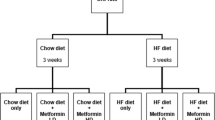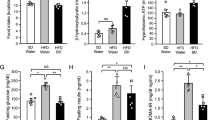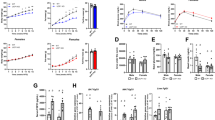Abstract
OBJECTIVE: We previously reported that a two week treatment with SKF 38393 (SKF, a dopamine D1 receptor agonist), plus bromocriptine (BC, a dopamine D2 receptor agonist) acted synergistically to normalize hyperphagia, body fat, hyperglycaemia and hyperlipidaemia in ob/ob mice. The present study further investigates the biochemical mechanisms triggered by this drug treatment.
DESIGN: Six week old female C57BL/6J ob/ob mice were divided into three groups and treated for two weeks with either BC and SKF, vehicle (control), or vehicle and pair fed to match the drug-treated group’s daily food intake.
RESULTS: BC/SKF treatment reduced food consumption by 55%, and treated mice weighed less than either pair fed or ad libitum fed controls after two weeks of treatment. Moreover, oxygen consumption was increased by 2.4-fold and the respiratory quotient (RQ) decreased from 1.23 to 0.96 (indicating a reduction in de novo lipogenesis) by drug treatment relative to ad libitum fed controls, but these parameters were unaffected by pair feeding control mice. The treatment also reduced blood glucose and free fatty acids (FFA) relative to pair fed and ad libitum fed controls. BC/SKF treatment (but not pair feeding) concurrently reduced lipolysis, lipogenic enzyme activities and hepatic gluconeogenic enzyme activities. Treatment also increased hepatic concentrations of glycogen and xylulose-5-phosphate (X-5-P), a key stimulator of glycolysis. Finally, BC/SKF, but not pair feeding, reduced the circulating concentrations of thyroxine and corticosterone, two hormones known to increase lipolysis, lipogenesis and hyperglycaemia. Drug treatment also increased serum dehydroepiandrosterone (DHEA) sulfate concentrations, an inhibitor of body fat store accumulation.
CONCLUSION: These findings demonstrate that BC/SKF treatment not only normalizes hyperphagia of ob/ob mice, but also redirects several metabolic and endocrine activities, independent of its effects on feeding to improve the obese-diabetic syndrome in ob/ob mice.
This is a preview of subscription content, access via your institution
Access options
Subscribe to this journal
Receive 12 print issues and online access
$259.00 per year
only $21.58 per issue
Buy this article
- Purchase on Springer Link
- Instant access to full article PDF
Prices may be subject to local taxes which are calculated during checkout
Similar content being viewed by others
Author information
Authors and Affiliations
Rights and permissions
About this article
Cite this article
Scislowski, P., Tozzo, E., Zhang, Y. et al. Biochemical mechanisms responsible for the attenuation of diabetic and obese conditions in ob/ob mice treated with dopaminergic agonists. Int J Obes 23, 425–431 (1999). https://doi.org/10.1038/sj.ijo.0800893
Received:
Revised:
Accepted:
Published:
Issue Date:
DOI: https://doi.org/10.1038/sj.ijo.0800893
Keywords
This article is cited by
-
Subcutaneous adipose tissue dopamine D2 receptor is increased in prediabetes and T2D
Endocrine (2023)
-
Experimental dopaminergic neuron lesion at the area of the biological clock pacemaker, suprachiasmatic nuclei (SCN) induces metabolic syndrome in rats
Diabetology & Metabolic Syndrome (2021)
-
Bromocriptine inhibits adipogenesis and lipogenesis by agonistic action on α2-adrenergic receptor in 3T3-L1 adipocyte cells
Molecular Biology Reports (2013)
-
Tesofensine, a Novel Triple Monoamine Reuptake Inhibitor, Induces Appetite Suppression by Indirect Stimulation of α1 Adrenoceptor and Dopamine D1 Receptor Pathways in the Diet-Induced Obese Rat
Neuropsychopharmacology (2010)
-
Hypothalamic neuropeptide Y (NPY) and the attenuation of hyperphagia in streptozotocin diabetic rats treated with dopamine D1/D2 agonists
British Journal of Pharmacology (2006)



